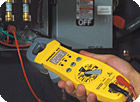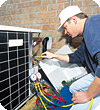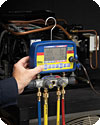As adults, the same advice holds true for the wide array of expensive tools that can be found in the back of any technician’s truck. Whether it’s power tools, meters, hand tools, or gauges, using the instruments the way they were intended and caring for them properly are the best ways to keep them in working order for a long time.
KEEPING SNIPS UP TO SNUFF
Snips are found on just about every job site and are versatile in that they can be used for cutting a variety of metals including cold-rolled steel, copper, and stainless steel. If you want to make them last, though, then never use them to cut electrical wire or any hardened material such as packaging straps, said Emily Furnal, senior product manager - hand tools, Lenox (www.lenoxsaw.com).
Field technicians should make sure the meter they plan to buy is designed specifically for HVACR field service. The multimeter should have the necessary safety features built-in and should use both LED and beeper indications. (Courtesy of Fieldpiece Instruments.)
Professional contractors rely on their snips many times throughout the average work day, and it is imperative that they are sharp and the spring functions every time. Most snips come well oiled; contractors should keep up this maintenance to ensure that the snips operate smoothly. Occasionally it will be necessary to adjust the blades, as this keeps them at the optimal distance for smooth cutting without overlapping. This can be done with the use of standard nut drivers and hex keys.
How do you know when it’s time to replace your snips? If you are trying to cut sheet metal and the material falls between the blades rather than being cut, that means the blades have spread. They can be tightened using a nut driver, but once the blades are worn out, it’s time for a new pair.
There are many different types of snips available. Contractors usually choose theirs depending on the type of cuts they will be making and the direction they will be cutting most often. For short, small cuts with a lot of fine detail, aviation snips are the tools of choice, noted Furnal.
For making cuts of 6 inches or longer, offsets provide the greatest benefit because they elevate the hand from the material. All snips cut straight, but red-colored snips have a slight angle to the blades that allows them to cut to the left as well. These are primarily used by right-handed contractors. Green snips are used by left-handed contractors.

Technicians should regularly maintain their test and charging manifolds and store them properly, if they want them to last a long time. (Courtesy of Yellow Jacket.)
MULTIMETER MAINTENANCE
Multimeters allow HVACR field technicians to measure nearly any combination of parameters, including CO, O2, relative humidity, temperature, air velocity, pressure, superheat, subcooling, wet bulb, vacuum gauge, static pressure, gas pressure, and current.The key to keeping these rugged tools operating correctly is to not store them in extreme temperatures, said Rey Harju, president, Fieldpiece Instruments (www.fieldpiece.com).
“Don’t leave a meter baking on the front seat of the service van or in the truck when it’s extremely cold or extremely hot outside. For the most part our meters can handle temperature swings, but it may take a bit of time to cool down or warm-up for accurate testing.”
In addition, Harju advises technicians to keep moisture out of their meters by keeping them away from water if possible. Proper maintenance includes cleaning the meter with a damp, soft cloth. Technicians should avoid using harsh solvents for cleaning meters; any cleaners should be spot tested on a small part of the meter surface before the entire meter is cleaned.

Contractors looking to buy new snips should look for ones with a higher grade spring, such as those made of chrome silicone rather than standard wire. This is the same grade spring used in the automotive valve springs on high-performance vehicles. (Courtesy of Lenox.)
“Ideally, you hang the meter by a magnet and connect to your test points using alligator clips. This takes no hands and minimizes the risk of electrical shock. Using one hand is better than using two, because it minimizes the potential of conducting electricity across your heart. Use one alligator clip and one test lead. You can either attach the test lead to the meter or hang the meter by its magnetic hanger.”
The lifespan of a multimeter varies by the use and abuse the technician dishes out and that the meter can take. Some techs who have taken care of their meters still use the first one they ever bought. For those who want to purchase a new multimeter, look for one that measures the parameters needed regularly, is rugged enough for field abuse, promotes safe working habits, and is easy to use. Harju also recommended looking for a meter with a magnetic holder, which makes one- and no-handed testing easier to do.

Pictured is the Digital Refrigeration System Analyzer, which allows the user to see pressure dynamics intuitively for quick and accurate diagnosis. (Courtesy of Yellow Jacket.)
CHECKING MANIFOLDS AND HOSES
All technicians rely heavily on their test and charging manifolds to ensure that an air conditioning system contains the proper amount of refrigerant. When looking for a new test and charging manifold, it is necessary to determine the size of the job, followed by knowing the type of refrigerant involved so the proper scales can be used.Once those criteria are determined, hoses are the next item to consider, said Brian Flynn, executive vice president, Ritchie Engineering Co., Inc. - Yellow Jacket® Products Division (www.yellowjacket.com). “If using the manifold for high-pressure applications or for use with POE oil, then the correct choice would be a hose that has an internal liner to protect against permeation and egression of moisture.”
To care for gauges and hoses, o-rings should be cleaned of any dirt and lubricated. As part of a standard maintenance program, the o-rings should also be changed regularly, as should the gaskets in the hoses. The manifold hoses should be kept out of direct sunlight when stored, as the rubber cover will deteriorate over time when exposed to UV rays.
Another way to ensure tool longevity includes protecting the manifold gauges from damage, which can be done by using the hook for storing the manifolds between uses. If stored with hoses, the open ends of the hoses should be connected to the anchor fittings to keep debris and moisture out of the hoses. The low-side gauge should not be overpressurized, and manifold pistons and seats should be rebuilt or lubricated when needed. Depressors should also be inspected regularly.
Using the test and charging manifold properly includes not using the manifold for pressures above the maximum gauge reading and not storing a hose or manifold filled with liquid refrigerant. The low-pressure port of the system should be connected to the low-side manifold port, and technicians should remember that high pressure in the system could damage the low-pressure gauge on the manifold.
Manifolds can last indefinitely, as they can almost always be rebuilt with readily available replacement parts. “The pistons need to be changed, and we recommend that the hoses be replaced after five years at a minimum. For this reason we date code the hoses,” said Flynn. “Hoses should be replaced when there is visible damage to the outer cover, and gaskets should be replaced as necessary.”
Contractors have many tools they need to have on hand in order for their technicians to properly perform their jobs. Using the tools as they were intended and keeping them properly maintained are sure ways of reducing the need to buy new tools all the time.
Publication date:07/30/2007


Report Abusive Comment